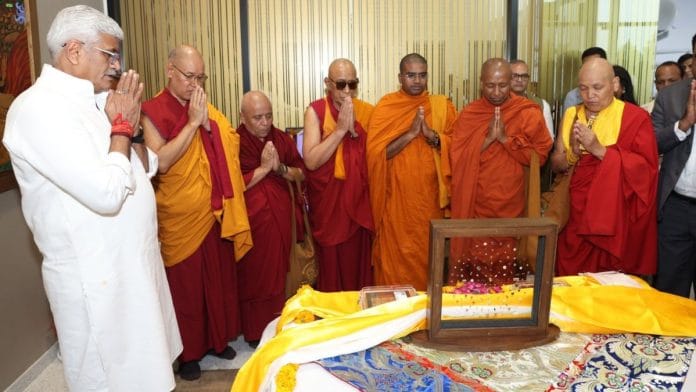New Delhi: The Government of India has repatriated the Piprahwa Gems from Hong Kong, two months after Sotheby’s called off a 7 May auction of the gems, following a word from New Delhi, cautioning about diplomatic and legal actions. The gems were expected to sell for 100 million Hong Kong Dollars.
The gems, associated with Buddhism and for long, a bone of contention between Indian and Hong Kong authorities, are now back in India after more than a century and 27 years.
The May auction had come under fire, as scholars and art historians argued that the storied gems are not subjects of commodification but are associated with the legacy and heritage of Buddha and Buddhists.
After the gems were brought back, Prime Minister Narendra Modi said in a post on X, “It would make every Indian proud that the sacred Piprahwa relics of Bhagwan Buddha have come home after 127 long years. These sacred relics highlight India’s close association with Bhagwan Buddha and his noble teachings. It also illustrates our commitment to preserving and protecting different aspects of our glorious culture.”
Union Culture Minister Gajendra Singh Shekhawat called the repatriation “an exemplary case of public-private partnership”.
“A large portion of the acquired collection will be on loan to the National Museum for five years, and Godrej Industries has agreed to display the entire gem collection upon its arrival in India for a period of three months,” Shekhawat said.
Naman Ahuja, a Delhi-based Art historian, was among the first to call out Sotheby’s for selling the precious gems in the market openly. “Are the relics of the Buddha a commodity that can be treated like a work of art to be sold in the market? And since they are not, how is the seller ethically authorised to auction them?”
He also questioned the ‘custodianship’ of the gems. “Since the seller is termed the ‘custodian’, I would like to ask—custodian on whose behalf? Does custodianship permit them now to sell these relics?”
Sotheby’s, which planned to sell the Piprahwa Gems, considered the artefact garlanded with pearls, rubies, topazes, and sapphires as “one of the most astonishing archaeological finds of the modern era” and “of unparalleled religious, archaeological and historical importance”. Sotheby’s description of the collection went “The Piprahwa Gems of the Historical Buddha”.
The auction house, Sotheby’s, is headquartered in New York City, its popular outlets are in London and Paris, and another one is in Hong Kong—where the Piprahwa Gems were supposed to be sold.
Also Read: The afterlife of stolen antiquities when they are returned to India
Piprahwa Gems & Buddha
The Piprahwa Gems trace their origin to a stupa, a dome-shaped monument in the village of Piprahwa, located in modern-day Uttar Pradesh. Siddharthnagar, the district under which Piprahwa falls, is named after Buddha.
It is widely believed that the gems were left mixed with some of the cremated remains of Buddha, believed to have died circa 483 B.C., 161 km from Piprahwa in Kushinagar.
During his excavations in 1898, English engineer William Claxton Peppé discovered the stupa at Piprahwa—south of Lumbini, the ‘birthplace of Lord Buddha’. Peppé, unknowingly, had unearthed one of the eight stupas, believed to contain ashes and fragments of Buddha.
The Sakya clan of Buddha built the stupa to honour the relics of their ‘illustrious kinsman, Gautama Buddha’, reveals the website ‘The Piprahwa Project’ run by the family of Peppé.
Since the excavation of Piprahwa Gems, the Indian Museum in Kolkata has housed a majority of the gems, while Peppé’s family retained about a fifth of them. At the time, the British colonial administrators described some of the gems as “duplicates”.
Acts of Extradition
The British could claim ownership of ‘treasure’ found in India, including archaeological finds, if they deemed the same as ‘treasure trove’, according to the 1878 Indian Treasure Trove Act. ‘Treasure’ was anything of substance hidden in or attached to the ground, and if that ‘treasure’ did not remain hidden for more than a century, the British could claim it. This Act justified the British claim over many artefacts found in the Subcontinent, including the Piprahwa Gems.
Now, the Indian Government has permitted Peppé’s family to retain only a portion of the relics, claiming the gems by leveraging the power of the Antiquities and Art Treasures Act, 1972, which prohibits the export of antiquities without government permission and criminalises unauthorised sales abroad. Dating back over 2,000 years, the Piprahwa Gems come under the jurisdiction of this Act.
Since the government recognises the Buddha relics as artefacts of national importance, it is bound to fall under the Ancient Monuments and Archaeological Sites and Remains Act, 1958, a law that protects structures and items of archaeological importance—especially if declared of national importance.
The government invoked these acts in a 5 May 2025 notice to Sotheby’s and the Peppé family, demanding “immediate cessation” of the auction and the repatriation of the relics. The Union Ministry of Culture posted on X that the auctioneer “responded to the legal notice, with the assurance that full attention is being given to this matter”.
The government was successful in Sotheby’s postponement of the 5 May auction of the relics till the house successfully oversaw the repatriation of Piprahwa Gems from foreign shores Wednesday afternoon.
Dedipya Agarwal is a TPSJ alum interning with ThePrint
(Edited by Madhurita Goswami)






